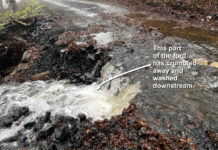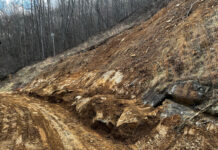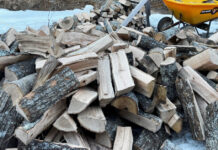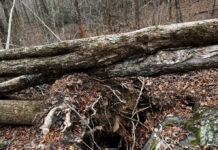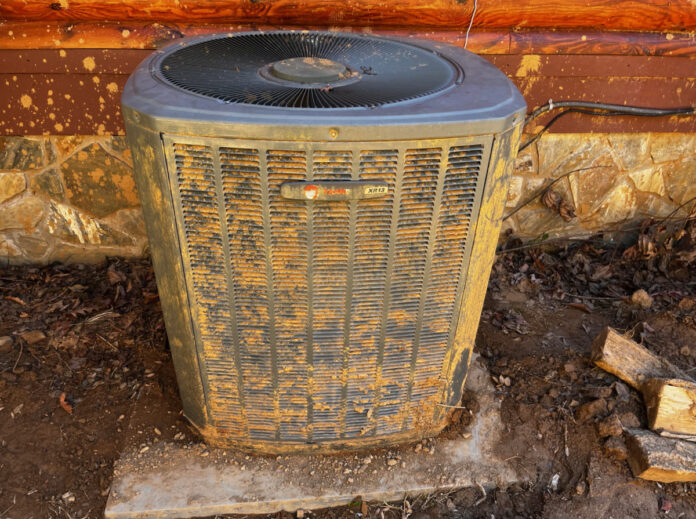
Our HVAC service company called to say they were sending out a repair tech to look at our heat pump. As you may recall, our landslide knocked the outside portion of the heat pump, which includes the compressor and condenser coil, off its platform. The landslide also pushed mud up against the exterior of the unit. When the volunteers were here to help, we dug it out, but I had hesitated to do anything else. I left it until a professional could tell me what to do.
“Huh,” said our local professional, looking at it, “This isn’t near as bad as some I’ve seen.” He opened it up and said we were lucky. The mud had not made it through the exterior vents, so there was no mud on the heat exchange portion inside. Those that flooded were full of sand and mud, we were not. It turns out a landslide is better than a flood, at least from an HVAC standpoint.
He brushed out much of the dirt using a stiff brush, checked a few things, and said, “Go ahead and power it up.” I ran inside, switched all the breakers and asked my wife to turn up the thermostat. A minute or two later, it kicked on. I had feared we might have broken a pipe and had lost all the refrigerant, but that wasn’t the case. Because the unit had only shifted about six inches, the copper lines bent rather than broke. The tech topped it off with half a pound of refrigerant and called it good.
Warm Again
The last time I had to buy a new air conditioner, it cost me $7,800, and that was before the recent bout of inflation. Happily, our service call, cleaning and repair cost well under $200. That’s a big relief and one more small step to getting things back to normal.
By the time the tech was done and I got inside, the house was 70°F. “Why is it so hot?” I asked my wife.
“You said turn the thermostat up high enough so it kicks on.” Well, she had a point, but I turned it back down to 64°.
While we heat with wood and try to minimize the use of our heat pump, it is handy when we are gone all day or even overnight. We set it at 60° or 64° and that keeps the house warm enough so we can warm things back up quickly when we start the fire. It’s also useful if we have company and they aren’t used to our chilly indoor temperatures.
Gardens and Farms Destroyed
Our garden survived Helene unscathed, but that is not the case for many, a sad thing for an area where people depend on their gardens for food and income. If your garden or farm flooded, you are not supposed to raise edible crops for the next six to 18 months. I think the length of time depends on which river you were on and whether the flood waters contained oil and chemicals or just sewage and household waste.
One farmer I know well said he had just one field damaged, a 4-1/2-acre field where he grew vegetables. He lost a foot of topsoil and had two feet of rocks piled into it by the river. The estimate for cleanup and repair is $50,000. Now imagine you had 20 acres, or 120. He is hoping for some federal money, but FEMA is treating everyone out here like we are all Trump voters. (Oh wait, we all were Trump voters.) The expense may explain why I have seen only one field that has been reclaimed from the river.
My wife has visited two gardens affected by the storm. One had raised beds, but they could no longer be seen. The dirt and silt deposited in the garden by the floodwaters was higher than the raised beds had been. The other garden had its soaker hoses and other infrastructure buried by the flood. They also found odds and ends in the garden, from pieces of wood to siding and roofing materials. They were carried in by the flood waters and left behind when the water retreated, like flotsam on a beach after high tide. I don’t know what those folks will do. Possibly bulldoze it all out of the way and start from scratch.
Business Losses
These farmers and gardeners will not only have to spend money to repair their fields, they will lose the income they would have generated. It also means fewer sellers at the farmers’ market and less farm-to-table offerings at local restaurants for the tourists.
Speaking of restaurants, I took my neighbor to “the big city” for a doctor’s appointment, and then we went out to lunch. Our usual restaurant was not serving water, tea or their normal beverages, only canned soda and bottled water. All our food was served on foam plates and with plastic utensils, and there was no ice. The waitress explained that while they had running water, the area was still under a boil advisory. In the restroom, you could flush, but you have to use a big container of fresh water to wash your hands.
The recovery is spotty because water and sewer systems differ by municipality. As we drove back home, we saw shopping centers and stores that had porta-potties in the parking lot, a sure sign that they had no sewer service. Another shopping center still had piles of mud in the parking lot. (Like snow, it had been plowed out of the way. Unlike snow, the piles of mud don’t go away by themselves.)
There were also plenty of highway signs saying this or that road was closed, no trucks on this road, etc. Several sections in Interstates are still closed and may be for months.
This explains why the GPS gave us such circuitous directions. We had allowed 15 minutes extra for a trip that is usually 90 minutes, and we needed every extra second. Between detours to avoid bridge outages and delays to go around road work, the trip took longer than usual.
Regional Disasters versus National or Global
Despite being a prepper for 30 years, Hurricane Helene is the only serious prepping incident I have experienced as a victim. I experienced Y2K, 9/11, the anthrax attacks, Katrina, and many others as an outsider, someone looking in or on but unaffected. Previous hurricane and blizzards have cut power for a few days and left downed trees, but nothing like this. Never before have I been the one that people came to help; it was always the other way round.
While I have covered what worked for us and what we wish we had done differently, I think the biggest realization is that the people in this region survived primarily because this was a regional incident and there was outside help available.
We were cut off by weather and washed out roads, but we still had help within just a few days. Helicopters rescued people and flew in supplies for days after the storm. The National Guard and the Red Cross showed up in four or five days. Most of those that needed to be rescued were. Supplies appeared and were distributed to anyone who needed them. People who had little, or no food were fed and given food; people who had no water were given cases of it. In ten days, there were shower facilities and laundry services in central locations. The immediate relief effort worked well, even though our area was more difficult to reach than many.
I can’t help but wonder what would have happened if there were no outside resources, or if the help had to come on ships from foreign governments. It would have been much uglier if this had been a nuclear attack, an explosion of the Yellowstone caldera, a hack that took down the national grid and the Internet, or another nation-wide disaster.
The Worst-Case Scenario
A scenario that kills millions, disrupts everything, and prevents outside support is the worst-case scenario for which we need to prepare. If you can live through the initial event or attack, then you have to be able to survive the aftermath, to sustain yourself and others, to form the mutual-support relationships, and to live for as long as it takes for the recovery to start. That’s a heavy lift, but it’s the target preppers ultimately need to set their sights on.
Prep to sustain yourself for three weeks, and you’ll be pretty well prepared for most regional emergencies. Will help come in three days? Maybe not, but it should in a week or two.
Then aim for six weeks. After you achieve that. look to survive three months. That’s a nice number, and you can feel good knowing you have three months of food and supplies. Next, aim for six and keep going until you reach a year. Now you are getting somewhere! But don’t let that stop you.
Food and water are a good start, but once you have a six-month supply, you need to think about where you are most likely to survive. That’s when it will strike home that survival is less likely in an urban or suburban setting. If you are serious enough to have a year’s supply of food, then you are serious enough to make prepping your lifestyle and move out of harm’s way. It’s the next logical step.
Take the Next Step
There is always another step. We just bought a solar power system, and now I want a side-by-side, a 2011 pistol, and gate at the end of my driveway. Those goals may not be achievable, or I may look back in a few years and see I have accomplished them or changed my goals. Either way, it never ends, but each step gets you closer to the ultimate: surviving the end of the world as we know it, or as we fear it will be.
Maybe it will be an economic collapse. Perhaps it will be a civil war or revolution. Maybe it will be a nuke, or more likely multiple nuclear devices used across the globe. It could be a comet hits us that causes tidal waves and earthquakes across half the globe. All I know is I am glad I prepped, my wife is glad I am a prepper, and I doubt this will be the last time we feel this way.

